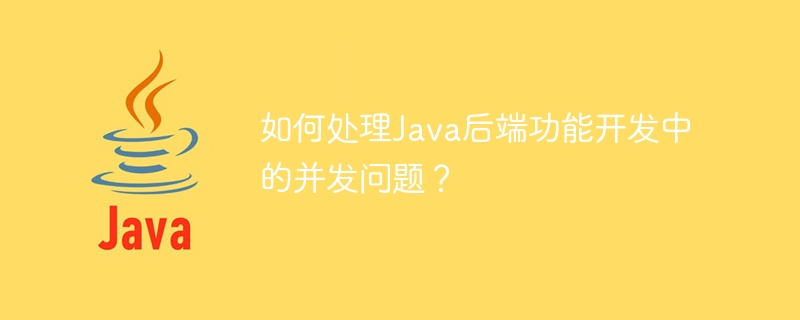Home >Java >javaTutorial >How to deal with concurrency issues in Java back-end function development?
How to deal with concurrency issues in Java back-end function development?
- 王林Original
- 2023-08-27 11:09:121504browse

How to deal with concurrency issues in Java back-end function development?
In the development of Java back-end functions, concurrency problems are often encountered. Concurrency problems refer to data inconsistencies or program logic errors that may occur when multiple threads access shared resources at the same time. In response to these problems, we need to take some measures to deal with concurrency and ensure the correctness and reliability of the program.
The following will introduce several common methods of dealing with concurrency problems, as well as corresponding code examples.
1. Locking Mechanism
Locking is the most common and direct way to deal with concurrency problems. Java provides the synchronized keyword and Lock interface to implement the locking mechanism.
- Use synchronized keyword locking
public class Counter {
private int count = 0;
public synchronized void increment() {
count++;
}
public synchronized int getCount() {
return count;
}
}In the above code, both the increment() and getCount() methods use the synchronized keyword locking, so that Ensure that only one thread can access these two methods at the same time to avoid concurrency problems.
- Use the Lock interface to lock
import java.util.concurrent.locks.Lock;
import java.util.concurrent.locks.ReentrantLock;
public class Counter {
private int count = 0;
private Lock lock = new ReentrantLock();
public void increment() {
lock.lock();
try {
count++;
} finally {
lock.unlock();
}
}
public int getCount() {
lock.lock();
try {
return count;
} finally {
lock.unlock();
}
}
}In the above code, we use the Lock interface to implement locking. Obtain the lock by calling the lock() method, and release the lock by calling the unlock() method in the finally block. This ensures that the lock can be released correctly when an exception occurs.
2. Use thread-safe data structures
In addition to the locking mechanism, we can also use thread-safe data structures to handle concurrency issues. Java provides some thread-safe collection classes, such as ConcurrentHashMap, CopyOnWriteArrayList, etc.
The following is an example of using ConcurrentHashMap:
import java.util.Map;
import java.util.concurrent.ConcurrentHashMap;
public class Counter {
private Map<String, Integer> countMap = new ConcurrentHashMap<>();
public void increment(String key) {
countMap.put(key, countMap.getOrDefault(key, 0) + 1);
}
public int getCount(String key) {
return countMap.getOrDefault(key, 0);
}
}In the above code, we use ConcurrentHashMap to store the value of the counter. ConcurrentHashMap is thread-safe and can ensure data consistency when multiple threads access it at the same time.
3. Use thread pool
Using thread pool can better manage thread resources and improve the efficiency of concurrent processing. The Executor framework in Java provides support for thread pools.
The following is an example of using a thread pool to handle concurrent tasks:
import java.util.concurrent.ExecutorService;
import java.util.concurrent.Executors;
public class TaskExecutor {
private ExecutorService executor = Executors.newFixedThreadPool(10);
public void executeTask(Runnable task) {
executor.execute(task);
}
public void shutdown() {
executor.shutdown();
}
}In the above code, we use the ExecutorService interface to create a fixed-size thread pool and execute() Method performs the task. After all tasks have been processed, the thread pool is shut down by calling the shutdown() method.
Summary:
It is very important to deal with concurrency issues in Java back-end function development. By locking mechanisms, using thread-safe data structures and using thread pools, we can effectively handle concurrency issues and improve program stability and performance.
I hope this article will help you understand and deal with concurrency issues in Java back-end function development. Thanks!
(Note: The above code examples are only for demonstration and do not consider all boundary conditions and exception handling. Please fully test and handle them in actual applications.)
The above is the detailed content of How to deal with concurrency issues in Java back-end function development?. For more information, please follow other related articles on the PHP Chinese website!

